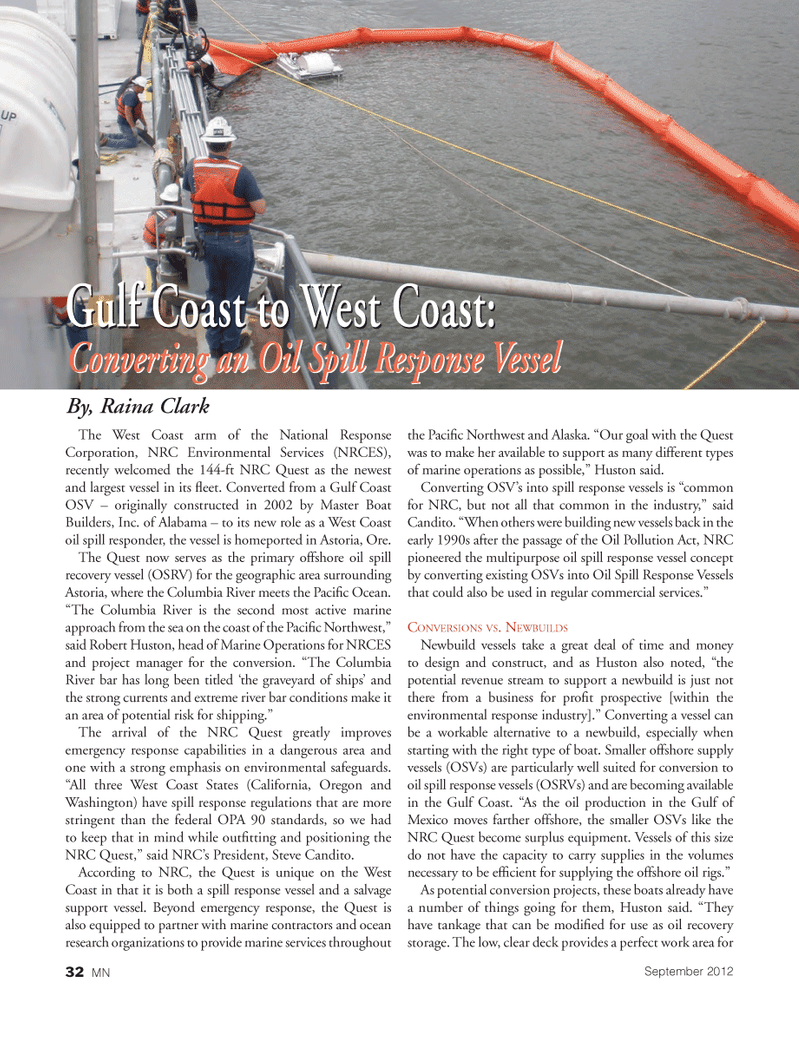
Page 32: of Marine News Magazine (September 2012)
Environment: Stewardship & Compliance
Read this page in Pdf, Flash or Html5 edition of September 2012 Marine News Magazine
The West Coast arm of the National Response Corporation, NRC Environmental Services (NRCES), recently welcomed the 144-ft NRC Quest as the newest and largest vessel in its ß eet. Converted from a Gulf Coast OSV Ð originally constructed in 2002 by Master Boat Builders, Inc. of Alabama Ð to its new role as a West Coast oil spill responder, the vessel is homeported in Astoria, Ore. The Quest now serves as the primary offshore oil spill recovery vessel (OSRV) for the geographic area surrounding Astoria, where the Columbia River meets the PaciÞ c Ocean. ÒThe Columbia River is the second most active marine approach from the sea on the coast of the PaciÞ c Northwest,Ó said Robert Huston, head of Marine Operations for NRCES and project manager for the conversion. ÒThe Columbia River bar has long been titled Ôthe graveyard of shipsÕ and the strong currents and extreme river bar conditions make it an area of potential risk for shipping.Ó The arrival of the NRC Quest greatly improves emergency response capabilities in a dangerous area and one with a strong emphasis on environmental safeguards. ÒAll three West Coast States (California, Oregon and Washington) have spill response regulations that are more stringent than the federal OPA 90 standards, so we had to keep that in mind while outÞ tting and positioning the NRC Quest,Ó said NRCÕs President, Steve Candito. According to NRC, the Quest is unique on the West Coast in that it is both a spill response vessel and a salvage support vessel. Beyond emergency response, the Quest is also equipped to partner with marine contractors and ocean research organizations to provide marine services throughout the PaciÞ c Northwest and Alaska. ÒOur goal with the Quest was to make her available to support as many different types of marine operations as possible,Ó Huston said. Converting OSVÕs into spill response vessels is Òcommon for NRC, but not all that common in the industry,Ó said Candito. ÒWhen others were building new vessels back in the early 1990s after the passage of the Oil Pollution Act, NRC pioneered the multipurpose oil spill response vessel concept by converting existing OSVs into Oil Spill Response Vessels that could also be used in regular commercial services.Ó CONVERSIONS VS. NEWBUILDS Newbuild vessels take a great deal of time and money to design and construct, and as Huston also noted, Òthe potential revenue stream to support a newbuild is just not there from a business for proÞ t prospective [within the environmental response industry].Ó Converting a vessel can be a workable alternative to a newbuild, especially when starting with the right type of boat. Smaller offshore supply vessels (OSVs) are particularly well suited for conversion to oil spill response vessels (OSRVs) and are becoming available in the Gulf Coast. ÒAs the oil production in the Gulf of Mexico moves farther offshore, the smaller OSVs like the NRC Quest become surplus equipment. Vessels of this size do not have the capacity to carry supplies in the volumes necessary to be efÞ cient for supplying the offshore oil rigs.Ó As potential conversion projects, these boats already have a number of things going for them, Huston said. ÒThey have tankage that can be modiÞ ed for use as oil recovery storage. The low, clear deck provides a perfect work area for Converting an Oil Spill Response Vessel Converting an Oil Spill Response Vessel Gulf Coast to West Coast: Gulf Coast to West Coast: Gulf Coast to West Coast: Gulf Coast to West Coast: Converting an Oil Spill Response Vessel Converting an Oil Spill Response Vessel By, Raina Clark September 201232 MNMNSept2012 Layout 32-42.indd 32MNSept2012 Layout 32-42.indd 328/30/2012 3:33:36 PM8/30/2012 3:33:36 PM

 31
31

 33
33
